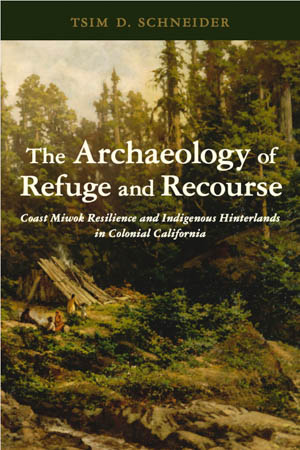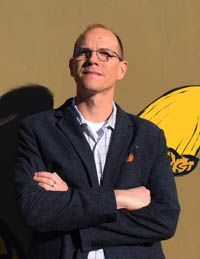In his latest book, Assistant Professor of Anthropology Tsim Schneider examines the history of Coast Miwok and Southern Pomo peoples in California from an Indigenous perspective, uncovering stories of resilience and continued connection to culture and homelands from the 18th through 20th century, despite multiple waves of colonial intrusion.
Schneider, who is a citizen of the Federated Indians of Graton Rancheria, has worked with his tribal community for more than 20 years to gather and interpret archival and archaeological evidence in new ways that combat the erasure of Indigenous peoples from historical narratives. The Archaeology of Refuge and Recourse: Coast Miwok Resilience and Indigenous Hinterlands in Colonial California shares these findings.
“Many anthropologists wrote off my culture a long time ago as being either extinct or on the verge of extinction because of the traumas of the mission period and the late 19th century, but we are still here, and we’ve been here all along,” Schneider said. “This book is an opportunity, as an archaeologist and anthropologist, to try to write my family and our culture and history back into existence.”
The Archaeology of Refuge and Recourse reconstructs histories of Bay Area Indigenous peoples partly through clues found across six archaeological sites within what is now China Camp State Park and Toms Point Preserve. Schneider and his collaborators centered Indigenous knowledge to guide where they looked, what they looked for, and how to interpret what they found. In that process, they documented what prior Euro-centric archeological research methods had overlooked.
Schneider says archaeologists are often trained to look for introduced materials—like glass, metal, and pottery—to answer questions about Native people after contact with Euro-American colonizers when, in fact, many important Indigenous cultural phenomena continued to incorporate natural materials that don’t leave the same physical traces. He also argues that archaeologists have misinterpreted artifacts found outside of missions as being prehistoric, rather than evidence of cultural resilience, perhaps due in part to prominent narratives about the extinction of Native cultures during the mission period.
“So we had a chance at China Camp State Park and Toms Point Preserve to bring a new understanding to the long-term occupational histories of these places through viewing the material assemblages differently,” Schneider explained.
At China Camp State Park, the historical site of several Coast Miwok villages, Schneider and his collaborators examined a series of traditional shell mounds and found evidence that these sites had continued to be in use throughout the mission period. The findings offered what Schneider calls “a more fine-grained picture” of Indigenous resistance during this time in history.
“People were running away from missions and seeking refuge in homelands that were still relevant to them, and they were going back to these places to hunt and gather, to hold dances, and to meet up with friends and family,” he said. “These are all ongoing processes that were taking place within Native communities, even while they were being oppressed by colonial institutions.”
Schneider also examined a series of sites around Toms Point to gain new insight into the lives of Indigenous peoples after the missions were secularized. Toms Point was home to a 19th-century trading post, established on traditional lands by a white settler who married with a local Coast Miwok family. Schneider said the site’s history shows how Indigenous people maintained long-term relationships to their homelands, including through selective engagement with colonial projects.
“Native families and communities came back together after the mission period to start picking up the pieces of their history and their identity, and they found really creative new ways to persist,” he said.
One of Schneider’s favorite examples of this concept is a collection of cutting tools found near Toms Point. Some tools had been produced from natural materials, such as obsidian and chert. Other tools were shaped out of dark green bottle-glass shards using similar traditional Indigenous knapping techniques. Schneider says these and other belongings are a demonstration of how Indigenous knowledge and ingenuity have helped to protect and prolong cultural traditions.
“To me, it really speaks to a process of resilience, or resisting the imposed structures that are pushing Native people out of the picture by constantly finding ways to reassert identity in these new contexts,” he said. “Native people have transformed their families and their cultures, but also maintained their traditions, and we're continuing to do that in the present day.”
Ultimately, Schneider hopes to see more of these types of stories incorporated into how history is taught for future generations, both in classrooms and at heritage sites like China Camp State Park and Toms Point Preserve. He also says continued improvements in the telling of history will require more Indigenous voices in archaeology and anthropology and a push for greater accountability among all practitioners within those fields.
“There are elders in my community who still have really strong memories about the often destructive forms of archaeology that were practiced in the mid-20th century and how that excluded Native voices,” Schneider said. “As an archaeologist and a tribal member, one of the best things I can do is to be cautious and proactive in working productively with my tribe and to always remain responsible to my community.”
Schneider will discuss his book alongside other citizens of the Federated Indians of Graton Rancheria during a virtual event on Nov. 8 from 4:00–5:30 p.m. This event is presented by the UC Santa Cruz American Indian Resource Center in partnership with the University Library Special Collections and Archives. Please register online to attend.




